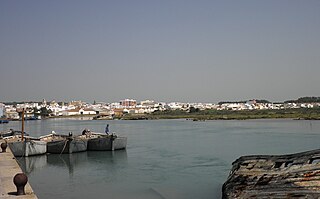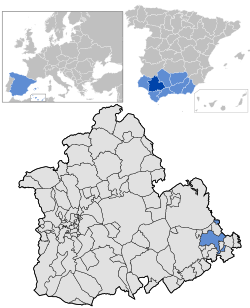
Andalusia is the southernmost autonomous community in Peninsular Spain. Andalusia is located in the south of the Iberian Peninsula, in southwestern Europe. It is the most populous and the second-largest autonomous community in the country. It is officially recognised as a historical nationality and a national reality. The territory is divided into eight provinces: Almería, Cádiz, Córdoba, Granada, Huelva, Jaén, Málaga, and Seville. Its capital city is Seville. The seat of the High Court of Justice of Andalusia is located in the city of Granada.

Seville is the capital and largest city of the Spanish autonomous community of Andalusia and the province of Seville. It is situated on the lower reaches of the River Guadalquivir, in the southwest of the Iberian Peninsula.

Córdoba, also called Cordova in English, is one of the 50 provinces of Spain, in the north-central part of the autonomous community of Andalusia. It is bordered by the Andalusian provinces of Málaga, Seville, Jaén, and Granada, the Extremaduran province of Badajoz and the province of Ciudad Real, which is part of the autonomous community of Castile-La Mancha. Its area is 13,769 km2.

The University of Seville is a university in Seville, Andalusia, Spain. Founded under the name of Colegio Santa María de Jesús in 1505, in 2022 it has a student body of 57,214, and is ranked 6th among Spanish universities.

Carmona is a town of southwestern Spain, in the province of Seville; it lies 33 km north-east of Seville.

María Díaz de Padilla was the mistress of King Peter of Castile, whom he posthumously recognised as his wife.

Morón de la Frontera is a Spanish town in Seville province, Andalusia, 57 km (35 mi) South-East of Seville. Situated in the south of the province, it is the center of the region that bears the same name and is the head of one of the 85 judicial courts of Andalucia.

Barbate is a Spanish municipality in the Province of Cádiz, in the autonomous community of Andalusia. It is a coastal town located on the shores of the Atlantic Ocean, close to the Strait of Gibraltar. Covering a total area of 142.17 km2, it has, as of 2019, a registered population of 22,518.

Alcalá de los Gazules is a city and municipality located in the province of Cádiz, Spain. According to the 2006 census, the town has a population of 5,633 inhabitants. Alcalá de los Gazules is situated in the Sierra de Cádiz.

El Ejido is a municipality of Almería province, in the autonomous community of Andalusia, Spain. It is located 32 km from Almería with a surface area of 227 km2, and as reported in 2014 had 84,144 inhabitants. El Ejido is the centre of production for fruit and vegetables in the "Comarca de El Poniente". The work opportunities the city provides attract many foreign farmhands, who look for jobs mainly in the greenhouses there. Some greenhouses have begun using computer-controlled hydroponics systems, thus saving on labour, improving efficiency and the local economy.
Purchena is a small town in Andalusia, southern Spain. It is situated inland the county of Almería, at the foot of the Sierra de los Filabres, in the middle of the Almanzora River Valley, surrounded by woods which ascend towards the mountains, an environment which contrasts with the rest of the municipalities of the area which are set in much more arid surroundings.

Aguilar, or in full Aguilar de la Frontera, is a municipality and town in the province of Córdoba, Andalusia, southern Spain, near the small river Cabra, 50 kilometres (31 mi) from the provincial capital, Córdoba, on the Córdoba-Málaga railway. As Ancient Ipagro, it also was an Ancient/medieval bishopric and remains a Latin Catholic titular see.
La Roda de Andalucía is a municipality of the Province of Seville, Andalusia, Spain. In 2005 it had a population of 4,322 inhabitants and an area of 320 square kilometres (124 sq mi). The density is 56.1 ihhab/km². It is located at an altitude of 405 metres (1,329 ft) and is 123 kilometres from Seville (city).
Salteras is a city in the Province of Seville, Spain. It has a population of 11,854 inhabitants. It borders Olivares to the west, Gerena to the northwest, Guillena to the north, La Algaba to the northeast, Valencina to the east and Espartinas to the south. Known to the Romans as Paesula, its origins are ancient. It was historically part of the Comarca del Aljarafe, but now legally forms part of the Comarca Metropolitana de Sevilla.
Olivares is a city located in the Province of Seville, Spain. According to the 2016 census (INE), the city has a population of 9480 inhabitants. It is located in the Aljarafe, the comarca downstream of the Guadalquivir and west of Seville. It borders Albaida to the west, Gerena to the north, Salteras to the east, and Sanlúcar la Mayor and Villanueva del Ariscal to the south. After the establishment of the House of Olivares, it grew in size and influence, becoming an important urban center in the Aljarafe.

La Guardia de Jaén or Guardia de Jaén, La, and the old Mentesa Bastia at Iberic and Roman era, is a small city located in the province of Jaén (Spain) at western end of Sierra Mágina, on the Cerro de San Marcos, near the promontory of Cerro de San Cristóbal, from where it dominates the valley of the river Guadalbullón.
With a population of 4061 inhabitants -according to January 2009 census (INE)-, is situated 635 m (2,083.33 ft) over sea level, with an area of 38.43 km2 (14.84 sq mi). Located some 10 km (6.2 mi) from Jaén, being the closest town, better communication with the capital thanks to the three tracks that bind: Jontoya highway bridge, road N-323 and Bailén-Motril motorway (A44/E-902).

Valdemoro is a municipal district, located in the Southern zone of the autonomous community of Madrid, Spain. Located 27 kilometers from the capital, Valdemoro is officially part of the comarca of La Sagra, though it is generally also included in the Madrid metropolitan area.

The Serranía de Ronda is a comarca in the western part of the province of Málaga, Andalusia, Spain. As is currently the norm in Andalusia, it has no formal status. The 2007 Statute of Autonomy of Andalusia, unlike its 1981 predecessor, mentions comarcas in Article 97 of Title III, which defines the significance of comarcas and establishes a basis for formal recognition in future legislation, but no such legislation has yet been enacted.
The copla, copla andaluza, canción andaluza, canción española, tonadilla or canción folklórica is a form of Spanish popular song, deriving from the poetic form of the same name. Although the genre has a long heritage, it flourished in the 1930s and 1940s, and is epitomized by songwriters Antonio Quintero, Rafael de León and Manuel Quiroga.

Rodrigo Gutiérrez Girón was a magnate and ricohombre from Palencia who played a key role in the Medieval history of the Iberian Peninsula. He was the first one of his lineage to add Girón to his patronymic. Owner of vast holdings and estates, Rodrigo and his relatives formed one of the most powerful clans in Tierra de Campos since the time of the Banu Gómez.





















